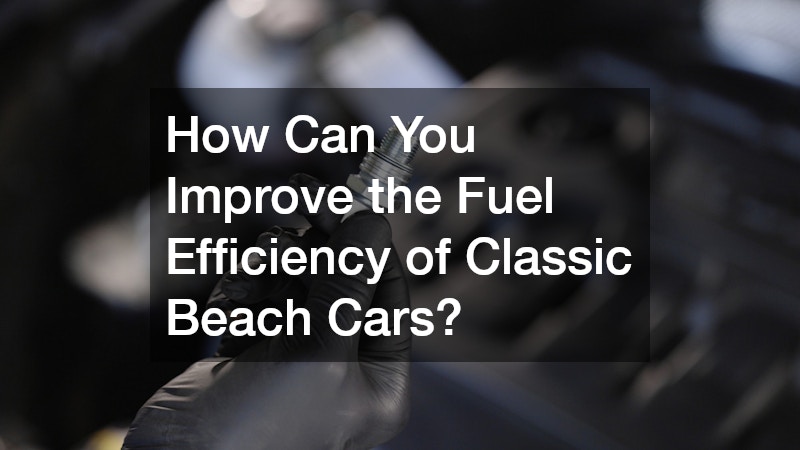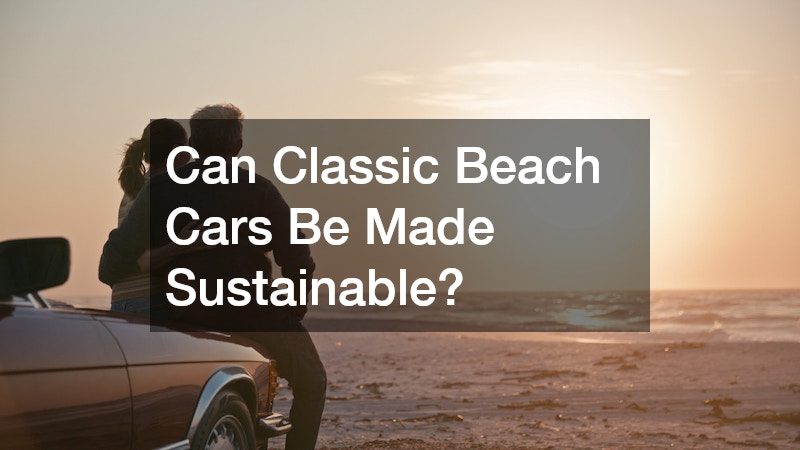Upgrading Classic Beach Cars for the Modern Day
Classics Meet Modernity
Classic beach cars hold a special place in automotive history and in the hearts of enthusiasts around the world. These open-air, rugged vehicles are symbols of sun-soaked coastal freedom—relics of simpler times when driving was about joy, not traffic. From the easy-going style of a Volkswagen Thing to the off-road prowess of a vintage Ford Bronco or Jeep Wagoneer, these vehicles conjure images of surfing, beach bonfires, and summer road trips.
But while these classics are visually and culturally iconic, the reality of owning and driving one today can be less idyllic. Outdated technology, inefficient engines, and a complete lack of modern safety features make many of them impractical for regular use. For this reason, owners and restorers are turning to upgrades—modifying their beloved classics to function seamlessly in the modern world without compromising their vintage soul.
Revamping classic beach cars is not about replacing their identity but enhancing their reliability, safety, and usability. In doing so, they remain roadworthy and relevant while preserving the distinct style and spirit that made them special in the first place.
What Are Classic Beach Cars?
Classic beach cars are vehicles designed or adapted for sandy, coastal environments. They typically feature convertible tops or open-air bodies, simple mechanical systems, and a sense of rugged charm. Cars like the VW Beetle convertible, the Meyers Manx dune buggy, and the Fiat Jolly are perfect examples. These vehicles evoke fun and leisure and have been embraced by generations of beachgoers and car lovers alike.
Because of their age and collectible status, many of these vehicles qualify for classic car insurance, a type of coverage tailored to vintage models. Unlike regular car insurance, these policies often operate on an agreed-value basis, which protects the car’s true worth instead of depreciating it over time. Owners must often demonstrate limited usage and proper storage conditions to maintain eligibility. This specialized insurance is just one of many considerations when owning a classic beach car in today’s world.
Why Upgrade Classic Beach Cars?
Despite their charm, most classic cars lack the features necessary for comfortable, safe, and efficient driving by today’s standards. Original braking systems, suspension setups, and powertrains were never intended to handle today’s traffic patterns or road conditions. In some cases, the cars may not even be street legal without modifications.
Upgrading these vehicles isn’t just about performance—it also has practical implications when it comes to insuring them. A modernized classic car is often viewed more favorably by an insurance agency, particularly when it includes updated safety features like disc brakes, LED lighting, or improved stability systems. These enhancements demonstrate a commitment to responsible ownership, which can lead to better coverage options, lower premiums, or additional protections under a classic car policy.
Upgrading is not about erasing the past. It’s about making these vehicles viable for regular use, ensuring they spend more time on the road and less time in the garage.
How Do You Maintain Vintage Style While Adding Modern Features?

The most successful restorations are those that balance modern performance with timeless aesthetics. It’s entirely possible to maintain the vintage look of a beach car while integrating current technology.
Car detailing plays a crucial role in this balance. Restorers often go to great lengths to preserve original paintwork, upholstery patterns, and dashboard layouts. Modern features are introduced subtly—such as replacing analog gauges with digital replicas that match the original styling or hiding Bluetooth connectivity behind a retro radio faceplate. Modern LED headlights can be made to look like classic sealed beams, and marine-grade seat materials can mimic old leather while offering superior durability.
This careful blending of old and new ensures the vehicle still turns heads at the beach while offering the conveniences we’ve come to expect from modern cars.
What Are the Most Popular Upgrades for Safety?
Classic beach cars, by design, were not built with modern safety standards in mind. Many early models came without seatbelts, crumple zones, or reliable braking systems. For a car to be truly roadworthy today, safety upgrades are essential.
One of the first areas restorers address is the braking system. Swapping out old drum brakes for newer disc brakes provides better stopping power and greater driver confidence. Seatbelts are usually added or upgraded from simple lap belts to more secure three-point harnesses. In open-bodied cars like dune buggies, roll bars may be installed for added protection during off-road adventures or rollover scenarios.
Lighting is another key area. Modern LED headlights and taillights not only improve visibility but also last longer and consume less power. Beneath the vehicle, components like the drive shaft are often reinforced or replaced to handle new performance loads or ensure compatibility with updated drivetrains.
These changes may not always be visible, but they can drastically improve both safety and performance without sacrificing vintage style.
How Can You Improve the Fuel Efficiency of Classic Beach Cars?

When these vehicles were first built, fuel economy was not a primary concern. Today, however, environmental awareness and rising gas prices make fuel efficiency a serious consideration for classic car owners.
One of the most effective ways to enhance fuel performance is through the use of turbo chargers. By forcing more air into the combustion chamber, turbo chargers enable more complete fuel combustion, increasing power output without the need for a larger engine. This not only boosts performance but also makes better use of each drop of fuel, offering gains in both horsepower and miles per gallon.
Aerodynamic enhancements can also play a role. While classic cars are often boxy and open, improving panel fitment or adding underbody shields can reduce drag. Upgrading the ignition system to a modern electronic ignition or switching from a carburetor to fuel injection can further optimize fuel usage.
Together, these changes transform a gas-guzzling relic into a more sustainable ride that retains its charm while being friendlier to both the environment and your wallet.
Are Electric Conversions Viable for Classic Beach Cars?
Electric vehicle (EV) conversions have gained traction as both a practical and sustainable solution for classic car lovers. Converting a vintage beach car to run on electricity eliminates emissions, reduces maintenance needs, and makes the vehicle exceptionally quiet and smooth to drive.
Interestingly, much of the technology used in electric beach car conversions is inspired by the golf cart industry. Compact electric motors and battery systems adapted from golf carts are ideal for small, lightweight vehicles like the VW Beetle or Fiat 500. The simplicity of beach cars makes them excellent candidates for electric conversions, particularly when daily driving involves short, coastal trips.
Electric conversions can be costly up front, and the work must be done carefully to preserve the vehicle’s structure and weight balance. However, the benefits are significant. Owners enjoy instant torque, regenerative braking, and the satisfaction of modernizing a classic without contributing to pollution. Though purists may lament the loss of the original engine sound, others see it as a bold step toward preserving these vehicles for future generations.
What Role Does Customization Play in Modern Upgrades?

Customization lies at the heart of any meaningful beach car upgrade. While preservationists may aim for museum-level authenticity, most owners embrace a more personal approach—one that celebrates both the car’s legacy and their own taste.
For example, upgrading an outdated wiper system with a modern electric wiper kit ensures visibility in unpredictable coastal weather. These upgrades are usually tucked away behind original hardware, blending function with style. Similarly, modern audio systems, USB charging ports, or GPS navigation are often added in ways that respect the vehicle’s original layout and appearance.
Some owners go beyond subtle changes and transform their vehicles into unique mobile lounges, surf support stations, or even beach-ready entertainment pods. Whether it’s a custom paint job, reupholstered seats in bold tropical prints, or teak decking in the cargo area, customization allows a classic beach car to reflect its owner’s lifestyle.
Modern upgrades and creative personalization go hand in hand. Together, they turn a classic car into a true expression of freedom.
How to Source Parts for Upgrades?
Sourcing parts for classic beach cars can be a challenge, especially for rare models or those with limited production runs. But with patience and a bit of resourcefulness, most components can be found or reproduced.
Many restorers turn to local salvage yards, especially those that cater to older vehicles or RVs. These businesses often carry hard-to-find trim pieces, window mechanisms, or compatible parts that would otherwise be out of production. Similarly, RV repair centers sometimes have parts that work with vintage beach cars due to similarities in design and manufacturing methods from the same era.
Online communities and marketplaces are also invaluable. Classic car forums, auction sites, and niche vendors offer a wide array of parts and advice. In some cases, custom fabrication is necessary, and specialized shops can recreate everything from dash panels to exhaust manifolds.
Restomod kits have become increasingly popular, offering pre-bundled components like upgraded wiring harnesses, suspension kits, or modern drivetrains. Whether you’re restoring a well-known model or an obscure gem, the parts are out there—you just need to know where to look and be willing to put in the time.
Can Classic Beach Cars Be Made Sustainable?

Sustainability may seem at odds with classic car culture, but the two can coexist. In fact, restoring and upgrading vintage vehicles is a form of recycling in itself, extending the life of something that might otherwise be discarded.
Beyond electric conversions, there are other ways to make a beach car more sustainable. Using eco-friendly or recycled materials during the rebuild, such as reclaimed wood trim or biodegradable interior fabrics, helps reduce environmental impact. Applying principles borrowed from truck maintenance—like reducing idling, optimizing tire pressure, and performing regular tune-ups—also enhances efficiency and longevity.
Reconditioning original parts instead of replacing them reduces the demand for new manufacturing. And in some cases, modifying engines to accept alternative fuels like biodiesel or ethanol can make the vehicle run more cleanly without a full drivetrain replacement.
Sustainability in classic car restoration isn’t about perfection—it’s about intention and progress. With careful choices, beach cars can evolve without abandoning their identity.
Who Are the Leading Figures and Companies in Beach Car Upgrading?
The movement to modernize classic cars has gained momentum, and a number of individuals and companies are now recognized for leading the charge. One such company is ICON 4×4, known for reimagining classic SUVs like the Ford Bronco with cutting-edge technology while maintaining vintage aesthetics. Zelectric Motors specializes in converting classic Volkswagens to electric power, offering packages that are clean, efficient, and visually faithful to the originals.
Singer Vehicle Design, although focused primarily on Porsche models, has inspired a generation of restorers with its obsessive attention to detail and craftsmanship. And while high-end brands may grab headlines, local towing and auto repair businesses near coastal towns have long been the unsung heroes of beach car restoration. These mechanics bring years of experience, community knowledge, and practical solutions to the table.
Together, this network of professionals, hobbyists, and companies helps keep the spirit of the classic beach car alive while preparing it for modern life.
Timeless Transportation
Classic beach cars have a unique ability to transport us—not just down the coastline, but back in time. They remind us of carefree adventures, salty air, and the joys of simple driving. Yet, to keep these beloved machines rolling into the future, upgrades are no longer optional—they are essential.
From safety and fuel efficiency to sustainability and style, upgrading classic beach cars is a way of honoring their legacy while ensuring they remain relevant and roadworthy. With the right approach, these timeless vehicles can be more than nostalgic artifacts. They can become reliable, efficient, and even eco-conscious companions for modern-day explorers.
The movement to modernize these vehicles is more than a mechanical endeavor—it’s a cultural revival. It bridges generations of car lovers, unites communities of restorers and innovators, and proves that heritage and innovation don’t have to be at odds. As the sun continues to rise on beaches around the world, one thing is certain: the classic beach car, updated and upgraded, still has many roads left to travel.
